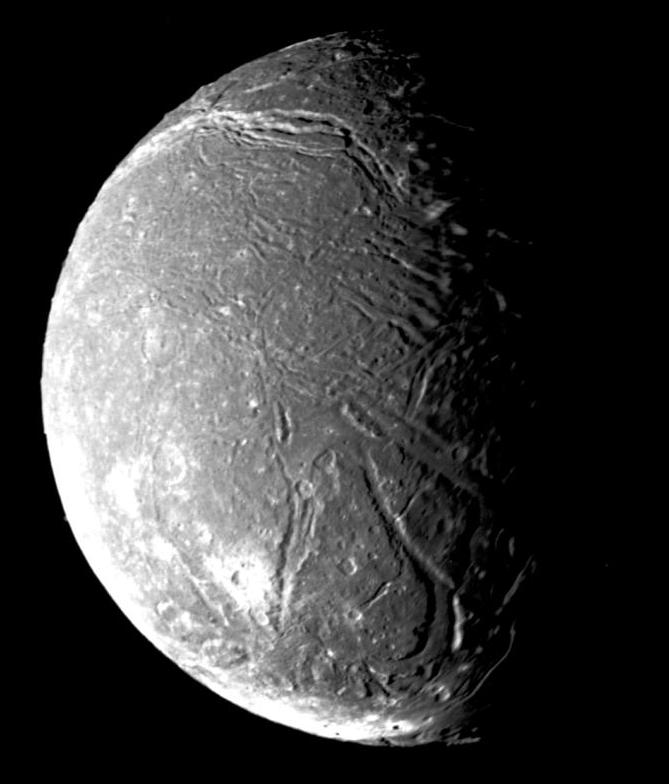| Distance to Uranus | 190 930 km |
| Period of revolution | 2.52 earth days |
| Diameter | 1158 km |
| Mass (Earth=1) | 0.0002260 |
| Density (water =1) | 1.66 |
| Composition | ice water (40-50%), rocks
and traces of NH3 and CO2 |
| Albedo | 0.25-0.30 |
| Temperature on the surface | -187 °C |
|
The surface contains a mix of cratered areas and valleys that are interlinked and spam many hundreds of km in length
and over 10 km deep. Some craters have lost their original from due to viscous relaxation phenomena.
The surface of Ariel is relatively young but nevertheless older than
Enceladus'. It can therefore be said that Ariel
has known past geological activity due to a hot interior. This heat that could have been created by tidal dissipation
was made possible by resonance with other satellites orbiting Uranus.
|
The valleys are in fact a consequence of a phenomenon of expansion of the crust
that could have occurred as the satellite cooled. The greater fractures were later filled
with younger materials (a similar process to the grabens). These more recent deposits are very plane relative to the other areas of the surface
and have fractures of their own but on a smaller scale. We don't know whether these fractures are tectonic in origin or if they
are a consequence of material falling into the valleys.
There is no certainty as to the structure of Ariel.
The little information at the disposal of research scientists are nothing but a few images by
Voyager 2 which was at 130,000 km from Ariel at closest approach. The model that agrees most with
these limited observations imply a differentiated structure (model 4 in the following figure).
Ariel would have a rocky core covered in a malleable mantel that would be malleable for the most part comprised of
ammoniac di-hydrate (NH3-2H20), and lastly a rigid crust of pure ice.
The presence of ammoniac could explain the deposits in the valleys. Indeed, the water
could not simply rise up and trickle down the valley. Due to the ambient temperature on the surface of Ariel water cannot exist in liquid state.
Ammoniac makes the material in the mantel malleable
(over large time scales).
Internal structure and composition
But other models, implying a less differentiated structure, have been equally put forward.
- Model 1: a mixture of undifferentiated (homogeneous) ice and rocks with traces of ammoniac, followed by a fine ice water crust.
- Model 2: a mix of undifferentiated (homogeneous) ice and rock followed by a crust of hydrated ammoniac.
- Model 3: a rocky core followed by a mantel of ice and a crust of hydrated ammoniac.
Ariel's spectrum in certain bands of wavelengths was obtained from Earth (Mauna Kea).
This allowed for other components that constitute the ice surface, like CO2 to be identified.
CO2 is only present in one of Ariel's hemispheres.
Figures 1 to 4 (credit: JPL/NASA)
2 and 3 Details of the surface:
the red: crater degraded by viscous relaxation
in blue: valley filled with more recent deposits
in green: small sinuous fracture in the deposits
4) different models of the internal structure for Ariel
(Prieto and J. Kargel)
